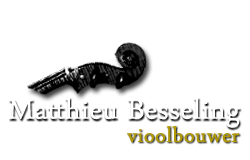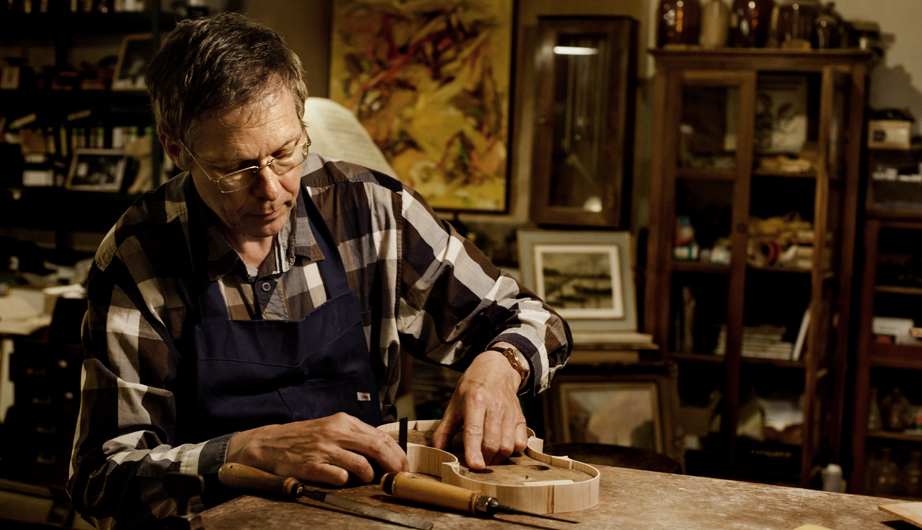'Each instrument must have something very much of its own, both in its sound and external appearance'.
Matthieu Besseling was born in Amsterdam on 6 December 1951. He began making violins when he was twelve, under the guidance of a violin maker Paul Gerhard Schmidt and his father, who was an amateur violin maker. He continued to make instruments while he was studying medicine and when he was at te conservatory (viola). In 1978 Besseling decided to make violin making his profession. He set up business in Amsterdam and since then he has largely occupied himself with making new instruments.
'I started to play the violin when I was six and I made my first violin when I was twelve. I grew up with them. My father was an enthusiastic amateur violin maker. He worked in the chemical industry and I was particularly interested in varnish. He was forever analysing and experimenting, along with other people, including the American varnish expert, Michelmann. In his opinion I was to young to make violins; the tools were too dangerous. But I just had to, and I was going to! So I went to one of his friends, the violin maker Paul Gerhard Schmidt, who secretly gave me a little wood and assistance. When he saw that I was serious, my father came round and helped me, too. That's how it began and even though after I left school I first followed a completely different course, I always continued to make instruments.
'When I am making a new instrument I always have my own ideal sound as a musician in my mind'.
First I studied medicine and I studied viola at the Amsterdam Conservatory. When I did my final exams at the Conservatory in 1978 I was also doing my housemanship. Sometimes I'd be in an empty lecture room in the middle of the night, playing my viola. A hectic time, especially because in the meantime I was still making instruments. Luckily I didn't need much sleep.
Meanwhile I had so many commissions to make instruments for fellow students that after the Exams I decided to make it my profession. I've never regretted it. Making violins is a fantastic profession. I almost exclusively make new instruments, all the stringed instruments, about twelve a year. I hardly repair at all - other than maintaining and repairing my own instruments, of course, that's part of the job. I think it's important that you stand behind your own work. It's also very instructive, actually, to see how an instrument develops. I do adjust other instruments, though. Musicians often come to me with acoustic problems. I find it's a great advantage that I play myself; I can usually immerse myself in the problems the client has with the instrument. When I am making a new instrument I always have my own ideal sound as a musician in my mind. That's why I play my instruments a lot. Each instrument must have something very much of its own, both in its sound and external appearance, but at the same time it must be all-purpose.
'The very best thing about this work is when all pieces of the puzzle fit together'.
As a modern violin maker I'm always conscious that I'm passing on a culture that is centuries old. That's not to say I slavishly copy the old masters, but it is important that you know why they did certain thinks. If you have a sufficient knowledge of the various styles, you can give them your own interpretation. You learn most by looking at instruments and by playing them. That's why I've been to lots of auctions and exhibitions and visited people who own beautiful instruments. I myself have a Ruggieri violin which I can use as a frame of reference.
'If I come across a bow I don't know, I keep digging away until I find out what it is'.
I usually make instruments to order and there is a waiting list. Sometimes I lend clients an instrument. During the waiting period, about a year, we use that as a sort of gauge for what I'm going to make for them. This means that contact is often very intensive.
It's sometimes quite a puzzle for a musician to find the right instrument. Another piece of the puzzle is the bow. They, too, all produce a sound of their own. I don't make bows, but I have a small collection, and they fascinate me. If I come across a bow I don't know, I keep digging away until I find out what it is. The very best thing about this work is when all pieces of the puzzle fit together. The right instrument and the right bow for the right person. The thinks which are the same for every instrument you make are less absorbing. Preparing the mould, gluing corner blocks; the necessary preliminary work, in other words. But that doesn't take very long and what comes after more than makes up for it.'
Text are taken from the book:
400 year violinmaking in the Netherlands.
1999 The authors and the Dutch group of violin and bow makers
ISBN 90 7297 782 3
This book is also available at the workshop of Matthieu Besseling himself.

